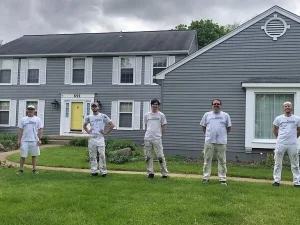Key Points
- Durability & Best Use: SuperPaint is more durable and ideal for high-traffic areas and exterior surfaces, while ProMar 200 is best for low-traffic interiors due to its lower durability.
- Coverage & Washability: SuperPaint requires fewer coats, offers better coverage, and is highly washable, whereas ProMar 200 needs more coats and is less scrub-resistant.
- Cost & Value: Both paints cost around $70 per gallon, but SuperPaint provides long-term value with fewer touch-ups, making it a better investment for durability.
Painting a Picture: Finding the Right Sherwin-Williams Paint for Your Home
Ever stared at a wall and wondered why some paint holds up for years while others fade, chip, or stain easily?
Have you struggled to decide which Sherwin-Williams paint will give you the best value for your money?
If you’re debating between ProMar 200 and SuperPaint, you’re in the right place.
This guide breaks down everything you need to know—from durability and coverage to cost and performance in Michigan’s unpredictable climate—so you can confidently pick the best option for your home.
By the end of this post, you’ll know exactly which paint fits your needs, whether you’re tackling an interior painting refresh or protecting your home’s exterior paint from harsh Midwest weather.
Ready to get started?
If you still have questions after reading, call Tribble Painting Company or fill out our contact form—we’d love to help!
ProMar 200 vs. SuperPaint: Quick Comparison
When selecting a quality paint for your home, it’s essential to weigh your options carefully.
Both Sherwin-Williams ProMar 200 and SuperPaint are well-regarded, but they serve different purposes.
One is a cost-effective choice for interior spaces, while the other offers durable paint suitable for high-traffic and exterior surfaces.
Below is a detailed comparison to help you decide which one best fits your needs.
Side-by-Side Breakdown
| Feature | ProMar 200 | SuperPaint |
|---|---|---|
| Best For | Interior walls in low-traffic areas | High-traffic interiors & exteriors |
| Durability | Moderate | High |
| Coverage | Requires more coats | Fewer coats needed |
| VOC Content | Zero VOC | Low VOC |
| Finish Options | Flat, Eggshell, Semi-Gloss | Flat, Satin, Semi-Gloss |
| Retail Price | ~$70 per gallon | ~$70+ per gallon |
| Washability | Less scrub-resistant | Easy to clean & highly washable |
Understanding the Purpose of Each Paint
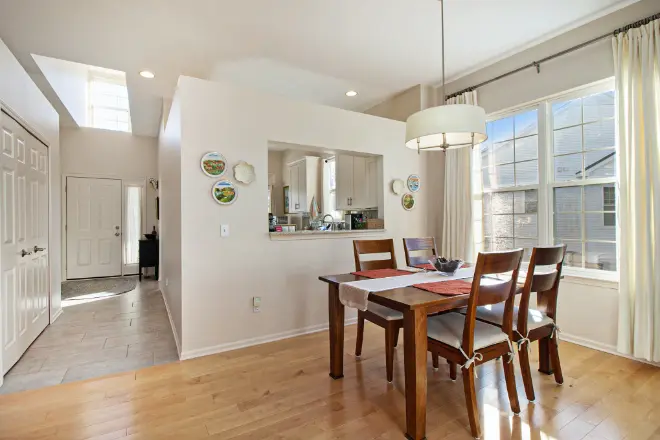
Not all paint is created equal, and choosing the right one for your project depends on the space, durability needs, and finish preferences.
Sherwin-Williams ProMar 200 and SuperPaint each serve distinct purposes.
Below, we break down what makes them different and when to use each option.
What is ProMar 200?
Sherwin-Williams ProMar 200 is a quality interior paint designed for professionals who need an affordable yet reliable option.
It’s often used in commercial settings, rental properties, and homes where cost-effectiveness is a priority.
- Zero VOC formula, making it safer for indoor air quality.
- Best suited for walls in low-traffic areas such as bedrooms, offices, and dining rooms. Follow the link to learn more about Sherwin-Williams’ top paint finishes for high-traffic areas.
- Comes in multiple sheen levels, including flat, eggshell, and semi-gloss.
- Requires multiple coats for full coverage, especially on darker colors.
- Not the most durable—may show wear over time, especially in high-touch areas.
This Sherwin-Williams Promar line is a better quality option than cheap contractor-grade paints, but it’s not the best paint for rooms that require frequent cleaning or durability.
What is SuperPaint?
For those seeking a durable and long-lasting option, SuperPaint is a standout.
This Sherwin-Williams product offers a paint-and-primer combo, making it an efficient choice for interior and exterior applications.
- Low VOC, but not zero, making it environmentally conscious while still highly effective.
- Excellent for high-traffic spaces, like hallways, kitchens, and playrooms.
- Available in flat, satin, and semi-gloss, allowing for a variety of finishes.
- Fewer coats are needed compared to ProMar 200, offering better coverage with each layer.
- Resists dirt, moisture, and fading, making it ideal for Michigan’s unpredictable climate.
If you’re looking for a durable interior paint or something strong enough to withstand exterior conditions, SuperPaint is a better quality option that provides long-term value.
Performance Comparison: Which One Lasts Longer?
Durability is a key factor when choosing paint, especially in Michigan, where temperature swings, humidity, and daily wear and tear can take a toll.
Both Sherwin-Williams ProMar 200 and SuperPaint offer solid performance, but one clearly outshines the other in high-traffic areas and long-term resilience.
Durability & Longevity
If you want a durable paint that holds up against constant use, SuperPaint is the better choice.
- ProMar 200: Best for walls in low-traffic areas but tends to show scuffs and marks over time.
- SuperPaint: Engineered for long-term durability, making it ideal for frequently touched surfaces like hallways, kitchens, and living spaces.
- SuperPaint’s thicker formula provides a stronger barrier against wear, moisture, and scrubbing.
For homeowners in Ann Arbor, Northville, Plymouth, Brighton, and South Lyon, where unpredictable weather and active households can strain interior and exterior surfaces, SuperPaint is the better quality investment.
Washability & Maintenance
If you need paint that can withstand regular cleaning, SuperPaint offers superior washability without losing its finish.
- ProMar 200: Wipes clean but can fade or rub off with excessive scrubbing.
- SuperPaint: Designed to resist stains, dirt, and moisture, making it easy to maintain.
- Best choice for homes with kids, pets, or high-traffic areas where messes are common.
Color Retention & Fading
If you want paint that stays vibrant longer, SuperPaint is the winner.
- ProMar 200: Holds color well indoors but may fade faster in sun-exposed areas.
- SuperPaint: Resists fading, even in direct sunlight, making it great for both interior and exterior use.
- Excellent for accent walls or rooms with large windows where UV exposure is a concern. Follow the link to learn how to create an accent wall with Sherwin-Williams paint.
Coverage & Application: How Many Coats Do You Need?
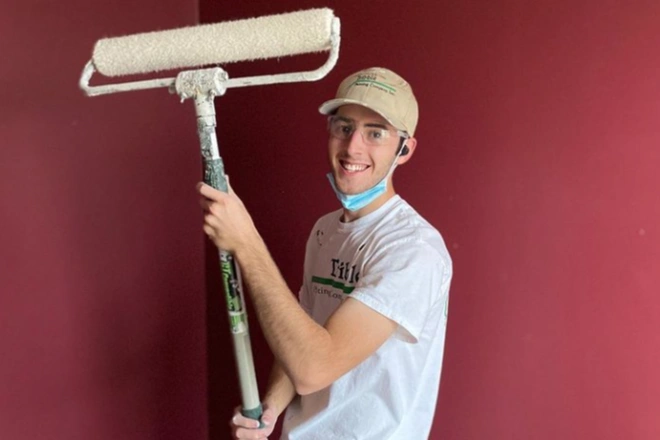
One of the biggest factors when selecting paint is how well it covers the surface and how many coats are necessary for a smooth, even finish.
Whether you’re painting drywall, touching up a house, or tackling a major renovation, knowing what to expect in terms of coverage and ease of application can save you time and money.
Coverage Per Gallon
The amount of paint needed for a project depends on surface texture, previous colors, and the type of Sherwin-Williams product you choose.
- ProMar 200: 250-400 sq. ft. per gallon, depending on surface porosity.
- SuperPaint: 350-450 sq. ft. per gallon, meaning you’ll likely need fewer coats to get the job done.
- SuperPaint’s thicker formula provides better coverage, making it an excellent choice for projects that require fewer coats and less touch-up work.
If you’re painting a house with textured walls, darker colors, or previously unpainted drywall, you may need additional coats for complete coverage.
Drying Time & Recoat Interval
Drying time plays a significant role in how quickly you can move through your painting project.
- ProMar 200: Dries to the touch in 30 minutes; ready for a second coat in 4 hours.
- SuperPaint: Similar drying time but better adhesion between coats, meaning fewer streaks or uneven spots.
- Both paints work well for quick projects, but SuperPaint requires fewer coats, making it more efficient.
Ease of Application
For homeowners and professional painters alike, ease of application is a major consideration.
- ProMar 200: Smoother application but may require extra coats for full coverage, especially on high-contrast color changes.
- SuperPaint: A bit thicker, meaning it can be harder to spread with a brush or roller, but it provides better overall coverage.
- Both paints are sold in flat, eggshell, and satin sheen options, making it easy to find the right finish for any room.
Best Use Cases: Where Should You Use Each Paint?
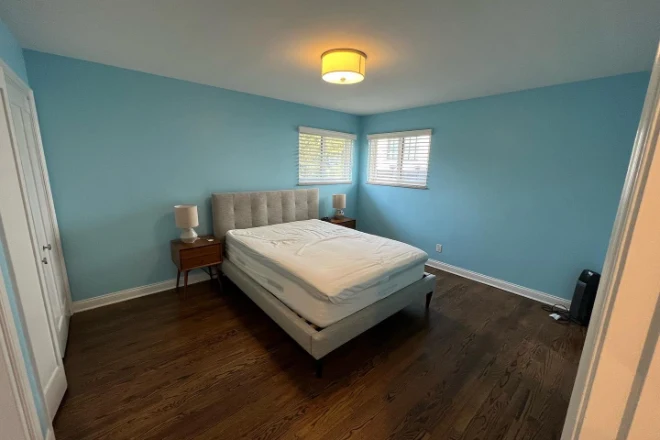
Not every paint is suitable for every space.
The right choice depends on the level of wear and tear, the amount of cleaning needed, and whether you’re painting interior walls or an exterior surface.
Below, we break down the best places to use Sherwin-Williams ProMar 200 and SuperPaint to help you get the most value for your investment.
Best Places to Use ProMar 200
Sherwin-Williams ProMar 200 is a great option for projects where budget and air quality matter more than extreme durability.
✅ Interior walls in low-traffic areas (bedrooms, offices)
✅ Spaces where zero VOCs are a priority (nurseries, hospitals)
✅ Budget-friendly projects requiring professional results
However, since ProMar 200 is not the most durable option, it may require touch-ups sooner, especially in rooms with high traffic.
Best Places to Use SuperPaint
If you’re looking for paint that provides better coverage, holds up to daily life, and requires fewer touch-ups, SuperPaint is the better choice.
✅ High-traffic areas (hallways, kitchens, bathrooms)
✅ Exterior surfaces exposed to weather
✅ Homes with children & pets (easy to clean)
Since SuperPaint is sold as both an interior and exterior product, it provides better long-term value for homeowners who want paint that stands up to Michigan’s seasonal weather swings.
Environmental & Health Considerations
When choosing paint, it’s essential to consider its impact on indoor air quality and environmental safety—especially in homes with children, pets, or individuals with allergies.
Both SuperPaint and ProMar 200 are designed to be low in harmful emissions, but they differ in their formulations.
VOC Levels & Air Quality
Volatile Organic Compounds (VOCs) can release harmful fumes into the air, affecting indoor air quality.
If you’re sensitive to strong paint odors or want a safer choice for enclosed spaces, VOC levels should be a priority.
- ProMar 200: A zero-VOC formula, making it ideal for nurseries, hospitals, and offices where air quality is a concern.
- SuperPaint: A low-VOC option, meaning it has minimal emissions but is not entirely VOC-free.
- Both paints are a good choice for Michigan homes, where winter forces windows to stay closed for months at a time.
For homeowners looking for paint that prioritizes indoor air quality, ProMar 200 is the better option.
Mold & Mildew Resistance
If you’re painting a house in Michigan, you’ll need a paint that can handle moisture—especially in bathrooms, basements, and kitchens, where humidity can lead to mold and mildew.
- SuperPaint: Contains acrylic resins and antimicrobial properties, making it resistant to mold and mildew in damp environments.
- ProMar 200: Offers basic mold resistance but is not specifically designed for humid spaces.
For homes in areas like Ann Arbor, Plymouth, and Brighton, where seasonal humidity can be a challenge, SuperPaint provides better protection against moisture-related issues.
Cost Breakdown: Which Paint Offers the Best Value?
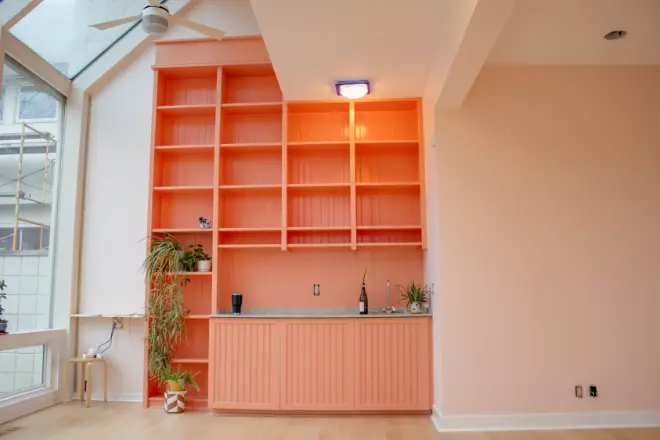
When comparing paint, the upfront price is only part of the equation.
Long-term value depends on durability, coverage, and maintenance costs.
While both SuperPaint and ProMar 200 are sold at a competitive price, they serve different needs, which affects their overall cost-effectiveness.
Upfront Costs
- ProMar 200: Typically priced around $70 per gallon, making it a more affordable option for large-scale projects like rental units or commercial spaces.
- SuperPaint: Costs slightly more at $70+ per gallon, but provides better coverage and requires fewer coats, which can save money on paint and labor.
- While both are in the same price range, SuperPaint offers better durability, meaning you’ll spend less on touch-ups and repaints over time.
Follow the link to explore the cost of painting a room with Sherwin-Williams paint.
Long-Term Value
The true value of a paint depends on how long it lasts before needing maintenance or a full repaint.
- ProMar 200: Requires more frequent touch-ups, especially in high-traffic areas, which can add to long-term costs.
- SuperPaint: Holds up better to wear, meaning fewer repaints and less maintenance over the years.
- The higher initial cost of SuperPaint is offset by its long-lasting performance, making it the better investment for Michigan homeowners who want a paint that stands up to seasonal changes.
Which Paint Saves You More Money?
- ProMar 200 is the budget-friendly choice for those prioritizing low upfront costs, especially in low-traffic areas or temporary spaces.
- SuperPaint is the better long-term investment, offering better durability, fewer repaints, and superior coverage, reducing overall expenses.
Final Verdict: Which Paint Should You Choose?
Choose ProMar 200 If…
✔ You need zero VOC paint for better indoor air quality.
✔ You’re painting low-traffic areas and want to save money.
✔ You don’t mind touch-ups over time.
Choose SuperPaint If…
✔ You need a durable, high-quality finish that lasts.
✔ You want better coverage with fewer coats.
✔ You’re painting high-traffic areas or exterior surfaces.
Follow the link to view a comparison of Benjamin Moore vs. Sherwin-Williams.
Tribble Painting Company Has the Perfect Paint Solution for Your Home
Now that you know the differences between ProMar 200 and SuperPaint, you can confidently choose the best paint for your project, whether you need a budget-friendly option for low-traffic areas or a durable finish that stands up to everyday wear.
With insights on coverage, durability, and cost, you’re equipped to make a smart investment that keeps your home looking its best for years to come.
If you’re ready to transform your walls with a flawless, professional finish, Tribble Painting Company is here to help.
Our expert team of house painters will ensure your home gets the perfect paint for its unique needs!
